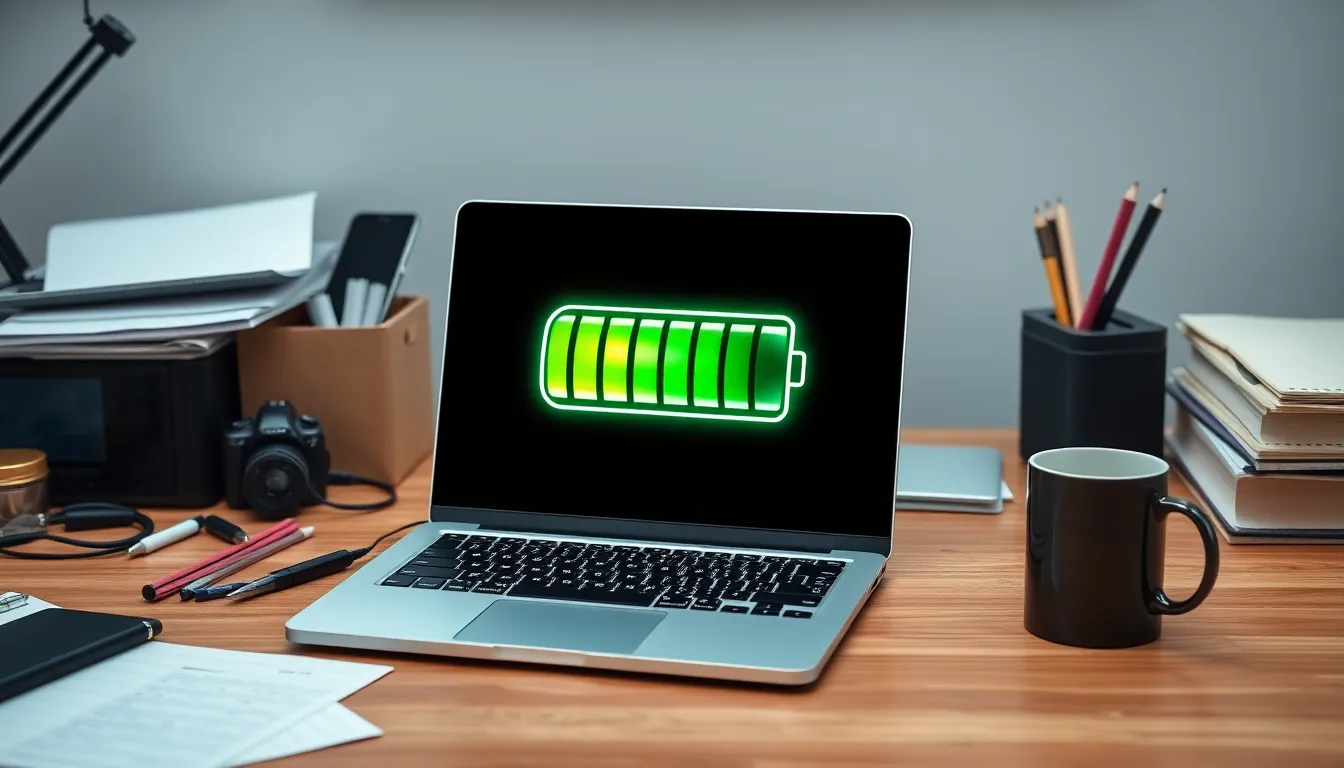Table of Contents
ToggleIn today’s fast-paced digital world, a reliable laptop battery is essential for productivity and convenience. As users rely more on their devices for work, entertainment, and communication, the need for enhanced battery performance has never been greater. Understanding how to extend battery life can significantly improve the overall user experience, ensuring that laptops remain functional throughout the day without constant recharging.
Laptop battery enhancement involves a mix of practical tips and advanced techniques. From optimizing settings to utilizing specialized software, users can take proactive steps to boost battery longevity. This article delves into effective strategies that not only maximize battery life but also improve laptop performance, making it easier for users to stay connected and efficient on the go.
Overview Of Laptop Battery Enhancement
Laptop battery enhancement involves a series of strategies and practices designed to improve battery life and performance. Several factors affect battery efficiency, including usage patterns, software settings, and hardware configurations.
Key Strategies for Enhancement
- Power Settings Optimization: Adjusting power settings can significantly extend battery life. Utilizing power-saving modes reduces energy consumption without compromising performance.
- Software Updates: Keeping the operating system and applications updated ensures optimal battery management. Manufacturers often release updates that fix bugs and enhance power efficiency.
- Resource Management: Closing unnecessary applications and background processes minimizes CPU load. Excessive resource usage can drain the battery rapidly.
- Battery Calibration: Regularly calibrating the battery helps maintain accurate charge reporting. Calibration involves fully charging the battery, then allowing it to discharge completely.
- Heat Management: Excess heat can damage battery cells and reduce lifespan. Using cooling pads or keeping the laptop on hard surfaces can improve ventilation and prevent overheating.
Advanced Techniques
- Specialized Software: Employing battery management software can track usage patterns and provide recommendations for optimization.
- Battery Replacement: Replacing an aging battery with a high-capacity option enhances longevity and performance.
- Hardware Upgrades: Upgrading to energy-efficient hardware components can reduce overall power consumption.
Incorporating these strategies and techniques provides users with effective methods to enhance laptop battery performance, ensuring reliability and efficiency throughout varied tasks.
Importance Of Laptop Battery Enhancement

Enhanced laptop battery performance plays a critical role in maximizing productivity and ensuring convenience for users. Improved battery capabilities directly correlate with extended device usability and overall efficiency.
Extended Lifespan
Extended battery lifespan significantly reduces the frequency of replacements, leading to cost savings for users. Enhanced batteries allow laptops to maintain performance over time, ensuring reliable operation during long work sessions or travel. Manufacturers design optimized batteries with advanced materials that endure charge cycles, prolonging overall functionality and decreasing waste through fewer discarded units.
Improved Performance
Improved battery performance results in a more responsive laptop experience. Efficient energy use enables consistent operational speeds and minimizes the need for frequent charging. Users experience quicker boot times, faster application launches, and superior multitasking capabilities as enhanced batteries provide sustained energy for demanding tasks. Implementing battery enhancement strategies guarantees higher productivity and satisfaction, making technology more efficient in daily use.
Methods For Laptop Battery Enhancement
Effective methods for enhancing laptop battery performance include utilizing battery management software and implementing hardware upgrades. These approaches significantly improve battery longevity and overall device efficiency.
Battery Management Software
Battery management software plays a crucial role in monitoring and optimizing energy consumption. Programs like BatteryCare and BatteryBar can provide insights into battery health, charging cycles, and usage patterns. These applications help manage power settings based on user behavior and detect processes consuming excessive energy, allowing users to make informed adjustments. Additionally, some software options offer features like sleep timers and intelligent charging, which minimize stress on the battery and extend its lifespan.
Hardware Upgrades
Hardware upgrades can lead to substantial enhancements in laptop battery life. Replacing aging batteries with high-capacity models increases runtime significantly, often providing 20-30% more usage time. Additionally, upgrading to energy-efficient components, such as solid-state drives (SSDs) and low-power processors, can reduce overall power consumption. These upgrades, combined with efficient cooling systems and eliminating unnecessary hardware, contribute to a more efficient laptop that conserves battery life effectively.
Tips For Maintaining Laptop Battery Health
Maintaining laptop battery health requires attention to charging practices and environmental considerations. Adopting effective strategies can significantly enhance battery performance and longevity.
Charging Practices
- Utilize optimal charging levels: Keep battery levels between 20% and 80% to maximize lifespan. Frequent full discharges or constant full charges can degrade battery chemistry.
- Employ gradual charging: Avoid rapid charging technologies if possible. Slow charging reduces heat generation, which can harm battery health.
- Unplug at 100%: Disconnect the charger once the battery reaches full capacity. Leaving it connected can cause trickle charging, which affects the battery over time.
- Monitor charging frequency: Charge the laptop when necessary, not compulsively. Frequent charging cycles can lead to diminished battery capacity.
- Use manufacturer-provided chargers: Always utilize chargers that meet the manufacturer’s specifications. Mismatched power outputs may damage the battery.
Environmental Considerations
- Avoid extreme temperatures: Store and use the laptop in environments with temperatures between 50°F and 95°F. High heat accelerates battery aging, while low temperatures can impair performance.
- Prevent exposure to humidity: Keep the laptop in dry conditions. Excess moisture can cause corrosion and damage internal components, including the battery.
- Minimize direct sunlight exposure: Avoid leaving the laptop in direct sunlight for extended periods. Sunlight increases heat, which can negatively impact battery performance.
- Ensure proper ventilation: Use the laptop on hard surfaces to avoid overheating. Soft surfaces can block ventilation ports, leading to increased temperatures and potential battery degradation.
- Consider travel conditions: During travel, protect the laptop from severe temperature fluctuations. Extreme conditions can adversely affect battery health.
Implementing these strategies helps maintain optimal laptop battery health, ensuring reliable performance and extended longevity.
Future Trends In Laptop Battery Enhancement
Advancements in laptop battery technology continue to evolve, focusing on greater efficiency and longevity. These trends indicate possibilities for significant improvements in battery performance.
- Solid-State Batteries
Solid-state batteries offer higher energy density and safety compared to traditional lithium-ion batteries. Their potential for faster charging and longer lifespan makes them a frontrunner in future laptop designs.
- Graphene Batteries
Graphene batteries integrate graphene material, which allows for rapid charging and increased storage capacity. Researchers expect these batteries to enhance laptop usage by providing extended durations between charges.
- Smart Battery Management Systems
Smart battery management systems use artificial intelligence to monitor and optimize battery performance. This technology analyzes user behavior to adjust power consumption, promoting longer battery life tailored to individual needs.
- Wireless Charging
Wireless charging technology continues to develop, promising convenience. Integration of this technology into laptops will eliminate the need for physical connectors, enhancing usability by enabling charging without a direct power source.
- Recycling and Sustainability
Future trends emphasize environmentally friendly battery production and recycling methods. Focus on sustainable materials will reduce environmental impact and promote resource efficiency, aligning with global initiatives for cleaner technology.
- Hybrid Power Sources
Hybrid systems that combine batteries with alternative power sources, such as solar energy, may become prevalent. These setups can significantly extend laptop usage duration while reducing dependency on conventional grid electricity.
- Flexible and Lightweight Designs
Advances in materials science allow for the development of flexible, lightweight batteries. These designs enable thinner laptop models without compromising battery life, appealing to consumers who prefer portability.
Continuous research and development in these areas suggests promising enhancements in laptop battery technology, potentially revolutionizing user experiences and productivity.
Enhancing laptop battery performance is essential for maximizing productivity in a fast-paced digital environment. By implementing practical tips and advanced techniques users can significantly extend battery life and improve device efficiency.
From optimizing power settings to utilizing specialized software the right strategies can lead to noticeable improvements. Additionally investing in high-capacity batteries and energy-efficient components can further elevate performance.
As technology evolves so do the possibilities for battery enhancement. Staying informed about future trends such as solid-state and graphene batteries will ensure users can take advantage of the latest advancements. Prioritizing battery health and sustainability will not only enhance the user experience but also contribute to a greener future.





